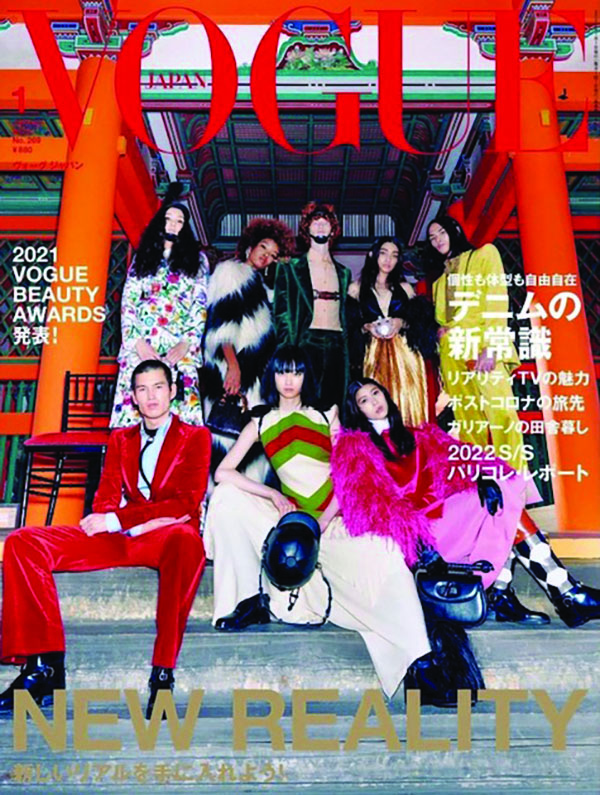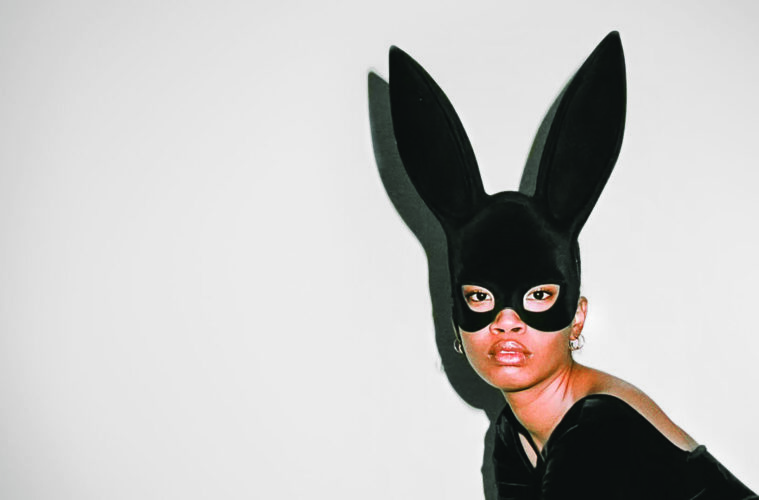Last year, Leiya Salis ’19 spent three days in Kyoto, Japan, being someone else. Standing on the steps of the Kiyomizu-dera, a Buddhist temple constructed nearly 400 years ago, she was clothed in head-to-toe Gucci with minimal makeup and a perfectly styled afro. She posed demurely in an oversized faux fur coat and miniature handbag. After the photo shoot wrapped, she traveled back home to Tokyo, where she changed into her usual uniform of jeans and a white tank.
More than 348,000 sets of eyes would view this version of Salis on the cover of Vogue Japan, according to the magazine’s number for print readership. The 26-year-old, who began her modeling career in early 2021, was featured alongside seven other up-and-coming models. For Salis, changing her identity is as easy as changing her clothes, a modeling prerequisite she gained inadvertently.

with other up-and-coming
models for Vogue Japan in
2021.
As a Black/Asian model (a rarity in Tokyo), she’s often hired by high-end companies looking to inject diversity into their campaigns. Most non-Asian models in Tokyo are white, Salis explains, a beauty standard left over from the post-war days. There are only a few Black and brown models in the country, she says. Coming from a multicultural background, representing a minority isn’t new for Salis, whose childhood was split between her mother’s native Japan and Ghana, where her father grew up. In both of those places, she changed her identity to assimilate, and it was only when she came to Colgate, where there were other multiracial students, that she started to develop her true sense of self. “I always felt like my identity was in flux and affected by the environment that I was in,” she says. “Maybe that’s why I find [modeling] to come so naturally, because I’ve had to unwillingly do that in a lot of situations, but now I’m willingly able to do it.”
The streets of Tokyo are buzzing with young creatives, and many models, like Salis, start out in the industry working collaboratively with designers to create pieces of art. For example, if there’s an aspiring photographer who’s looking for a model who’s good at expressing themselves creatively through their body and face, they’ll team up with budding stylists and makeup artists to build a photoshoot. “We’ll all just find each other on the street, at bars, at clubs,” she says. But in recent months, she’s proved her modeling talent, landing shoots with Nike, the luxury fashion brand Sacai, and the casual knit label YOKE. “While I’m in this space, I hope that I make some impression or impact that pushes brands and people to be more inclusive and more conscious of the messages they’re encouraging by hiring certain types of people,” Salis says.
Still, she often finds herself disparaged by voices upholding negative stereotypes of models. Salis thrived in Colgate’s academic environment, and she worked a series of corporate jobs before taking on her new creative role. And, she still has side gigs, like her podcast, Behind the Change, and Commu, a social justice organization she works with. “People find it very surprising that I graduated from college and I’ve worked in other positions [or] that I do other types of work,” she explains. “You can be a lot of things, you can do a lot of things. There’s no reason to just be one person.”
Salis designed her Colgate major — media, culture, and communication — after taking a course during the Manchester Study Group. “So much of how we understand ourselves is shaped through [media], and how we understand others is shaped through that [too],” she elaborates.

